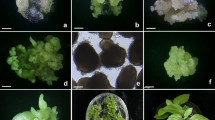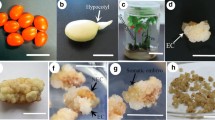Abstract
An efficient and reproducible procedure is established for the plant regeneration from hypocotyl explants and hypocotyl-or stem-derived calli in Astragalus melilotoides. High frequency somatic embryo formation (98.3%) occurred direct on hypocotyls on Murashige and Skoog (MS) medium supplemented with 2.69 µM NAA and 4.44 µM BA within 5 weeks. Three types of calli were induced from the hypocotyl and stem segments on MS medium containing 9.05 µM 2,4-D and 2.22–4.44 µM BA. Both somatic embryos and adventitious buds were initiated from hypocotyl-derived calli while only adventitious buds were formed from stem-derived calli in MS medium supplemented with 2.69 µM NAA and 4.44–8.89 µM BA. Somatic embryos or adventitious buds developed into plantlets following being cultured for 3 weeks on MS medium without any growth regulators or with 14.78 µM IBA, respectively. All the regenerated plants were normal with respect to morphology and growth characters, and produced fertile seeds after planting in soil.
Similar content being viewed by others
References
Barna KS & Wakhlu AK (1995) Direct somatic embryogenesis and plantlet regeneration from immature leaflets in chickpea. In Vitro Cell Dev. Biol. Plant 31: 137–139
Bespalhok JC & Hattori FK (1998) Friable embryogenic callus and somatic embryo formation from cotyledon explants of African marigold (Tagetes erecta L.). Plant Cell Rep. 17: 870–875
Denchev P, Velcheva M & Atanassov AI (1991) A new approach to direct somatic embryogenesis in Medicago. Plant Cell Rep. 10: 338–341
Guo BZ, Zhang HZ, Pan JT, Yang YC, Wu ZL, He TN, Zhou LH & Huang RF (1987) Flora of Qinghai Economic Plants, Section I (pp. 312–314). Qinghai People's Press, Xining, China
Guo SJ (1987) Astragalus melilotoides Pall. In: Jia SX (ed) Flora of the Chinese Forage Plants, Vol. 1 (pp. 213–215). Agricultural Press, Beijing
Hunault G (1984) In vitro culture of fennel tissues (Foeniculum vugare Miller) from cell suspension to mature plant. Sci. Hortic. 22: 55–65
Jing DW & Huang WH (1987) Medicago sativa L. In: Jia SX (ed) Flora of the Chinese Forage Plants, Vol. 1 (pp. 275–287). Agricultural Press, Beijing
Kim SW, Park MK & Liu JR (1996) High frequency plant regeneration via somatic embryogenesis in cell suspension cultures of coriander (Coriandrum sativum L.). Plant Cell Rep. 15: 751–753
Li XQ & Demarly Y (1996) Somatic embryogenesis and plant regeneration in Medicago suffruticosa. Plant Cell Tiss. Org. Cult. 44: 79–81
Luo JP & Jia JF (1998) Callus induction and plant regeneration from hypocotyl explants of the forage legume Astragalus adsurgens. Plant Cell Rep. 17: 567–570
Maheswaran G & Williams EG (1986) Clonal propagation of Trifolium pratense, T. resupinatum and T. subterraneum by direct somatic embryogenesis on cultured immature embryos. Plant Cell Rep. 5: 165–168
Murashige T & Skoog F (1962) A revised medium for rapid growth and bioassays with tobacco tissue cultures. Physiol. Plant. 15: 473–497
Neves LO, Duque SRL, Almeida JS & Fevereiro PS (1999) Repetitive somatic embryogenesis in Medicago truncatula ssp. Narbonensis and M. truncatula Gaertn cv. Jemalong. Plant Cell Rep. 18: 398–405
Nolan KE, Rose RJ & Gorst JR (1989) Regeneration of Medicago truncatula from tissue culture: increased somatic embryogenesis using explants from regenerated plants. Plant Cell Rep. 8: 278–281
Pedroso CM & Pais MS (1995) Factors controlling somatic embryogenesis. Plant Cell Tiss. Org. Cult. 43: 147–154
Pupilli F, Damiani F, Pezzotti M & Arcioni S (1989) Plant regeneration from callus protoplasts of Onobrychis viciaefolia Scop (sainfoin). Plant Sci. 63: 87–94
Radionenko MA, Kuchuk NV, Khvedinich OA & Gleba YY (1994) Direct somatic embryogenesis and plant regeneration from protoplasts of red clover (Trifolium pratense L.). Plant Sci. 97: 75–81
Rybczynski JJ (1997) Plant regeneration from highly embryogenic callus, cell suspension and protoplast cultures of Trifolium fragiferum. Plant Cell Tiss. Org. Cult. 51: 159–170
Tian YJ & Xi T (1989) The tissue culture and plant regeneration of Astragalus melilotoides (in Chinese). Plant Physiol. Commun. 25: 44
Vasil IK (1988) Progress in the regeneration and genetic manipulation of cereal crops. Biotechnology 6: 397–402
Zhang GN, Jia JF, Hao JG & Chen G (2003) Cytological observation and analysis of isoenzyme patterns in three types of hairy roots transformed by Agrobacterium rhizogenes A 4 (in Chinese). Acta Bot. Boreal. Occident. Sin. 23: 1533–1538
Zhang XQ, Wang XP & Yang Y (1994) Plant regeneration from monocell culture of Astragalus melilotoides (in Chinese). Grassland China 3: 50–54
Author information
Authors and Affiliations
Rights and permissions
About this article
Cite this article
Hou, SW., Jia, JF. High Frequency Plant Regeneration from Astragalus melilotoides hypocotyl and stem explants via somatic embryogenesis and organogenesis. Plant Cell, Tissue and Organ Culture 79, 95–100 (2004). https://doi.org/10.1023/B:TICU.0000049445.69802.50
Issue Date:
DOI: https://doi.org/10.1023/B:TICU.0000049445.69802.50




